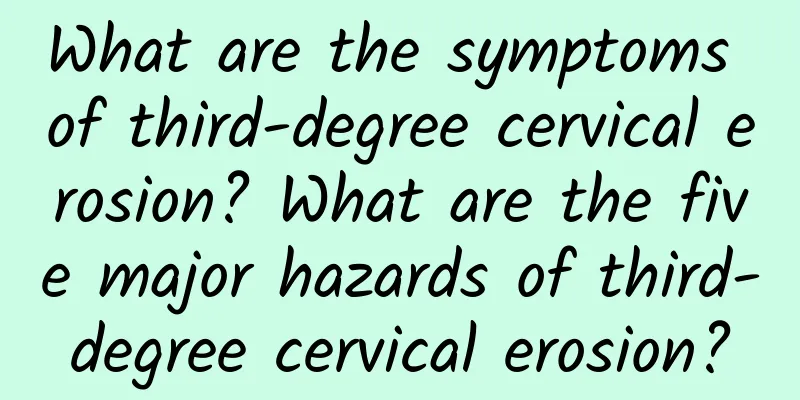What are the symptoms of third-degree cervical erosion? What are the five major hazards of third-degree cervical erosion?

|
Third degree cervical erosion is the most severe symptom of cervical erosion and the "ultimate version" of cervical erosion. The chance of canceration is the highest during this period. Women often suffer from third degree cervical erosion because mild cervical erosion is not discovered and treated in time, leading to the deterioration of the disease. Third degree cervical erosion is more harmful to women's health. What are the symptoms? Symptoms of third degree cervical erosion 1. Abnormal and increased leucorrhea This is the main symptom of cervical erosion. The characteristics of leucorrhea are closely related to the scope and degree of erosion. When cervical erosion is at the third degree, the leucorrhea is often yellow, purulent and sticky. The erosion area is relatively large and the amount of leucorrhea is large. Occasionally, there may be a small amount of blood or blood. Some people may also have contact bleeding. 2. Lower body pain When the cervical erosion reaches the third degree, it may cause chronic paracervical connective tissue inflammation, resulting in lumbar pain, pelvic pain and dysmenorrhea. If the inflammation spreads to the main ligament, sexual intercourse pain may occur, affecting sexual life. 3. Accompanied by other inflammations When cervical erosion reaches the third degree, it often causes inflammation of the cervix. In addition, inflammation of the cervix can spread or directly spread to the bladder triangle, thereby stimulating the bladder to cause symptoms of frequent urination and painful urination, and sometimes can also cause secondary urinary tract infection. 4. Irregular menstruation There are three levels of severity of cervical erosion: mild erosion, moderate erosion and severe erosion. However, as long as cervical erosion occurs, it will affect women's menstrual cycle, menstrual volume, etc., and sometimes dysmenorrhea will occur. The harm of third degree cervical erosion 1. Injury to the urinary system Long-term stimulation of cervical inflammation may cause other gynecological inflammations, such as: the pathogens of cervical erosion can ascend to cause cervical endometritis; it can spread through the paracervical ligaments and lymphatic vessels to cause chronic pelvic inflammatory disease; when the inflammation spreads to the bladder triangle, it can cause irritating symptoms such as urinary pain, frequent urination or difficulty urinating. 2. Spread of germs The pathogenic bacteria of this disease may also spread along the parauterine ligaments and lymphatic vessels, leading to chronic pelvic inflammatory disease. If the urinary system is affected, it may also cause urinary irritation. 3. Deep lesions Since chronic inflammation has not been treated safely and effectively for a long time, coupled with the stimulation of drug side effects, it can cause more serious diseases such as polyps, lacerations, ectropion and cysts, causing greater pain to women. Sometimes they have to resort to painful physical and surgical methods for treatment, which also have a certain impact on the quality of life in the future after surgery. 4. Damage to the reproductive system The texture and secretion amount of cervical mucus are directly related to whether sperm can pass through the cervix into the uterine cavity. Under normal circumstances, during the ovulation period, under the action of female hormones, the cervical mucus contains more water and has a thin texture, which is conducive to the passage of sperm. When cervical erosion occurs, especially moderate to severe cervical erosion, cervical secretions will increase significantly, become thick in texture, and contain a large number of white blood cells, which will have an adverse effect on sperm motility and hinder sperm from entering the uterine cavity, thereby affecting conception. 5. Cause infertility Because cervical erosion is severe, the cervical secretions increase significantly, contain a large number of white blood cells, and are viscous, which is not conducive to sperm activity, thus affecting conception and causing female infertility. Warm reminder: Third degree cervical erosion is often caused by mild cervical erosion not being discovered in time and moderate cervical erosion not being treated in time. Therefore, once cervical erosion is diagnosed, even if there are no symptoms, you should not be careless and think that nothing is wrong. Instead, you should receive timely and active treatment to prevent the occurrence of third degree cervical erosion, infertility and cervical cancer. |
>>: How to treat adnexitis and cervicitis 5 methods can treat adnexitis and cervicitis
Recommend
Classification of causes of hyperprolactinemia
What are the types of hyperprolactinemia? Accordi...
Is there any relationship between cervical erosion and IUD insertion?
Cervical erosion is the original name, and now it...
How much does it cost to treat cervical warts?
For patients with high-risk cervical warts, the c...
Why do early symptoms of ectopic pregnancy become more severe?
Experts say that many women are worried about hav...
How to regulate scanty menstruation
Light menstrual flow can be a problem for many wo...
What to do if bacterial vaginosis keeps recurring
What should I do if bacterial vaginosis keeps rec...
Survey: About 40% of Chinese people gain 1.7 kg after the Chinese New Year! 5 dietary tips to eat New Year's Eve meals wisely
Eating lots of meat and fish during the Spring Fe...
The most effective preventive measures for vaginitis in life
Vaginitis is the most common gynecological diseas...
Uterine amenorrhea and its causes
Uterine amenorrhea is caused by the pathology or ...
What are the symptoms of cervicitis?
Do you know about cervicitis? Do you know the sym...
Why does premature ovarian failure occur?
Premature ovarian failure refers to amenorrhea be...
Why does pelvic inflammatory disease recur?
Why does pelvic inflammatory disease recur? There...
The occurrence of ectopic pregnancy may also be related to repeated abortions
The occurrence of ectopic pregnancy may also be r...
Nursing methods for fungal vaginitis during lactation
Nowadays, women are suffering from more and more ...
Things that can cause miscarriage if a pregnant woman touches them
Pregnant women may experience miscarriage if they...









